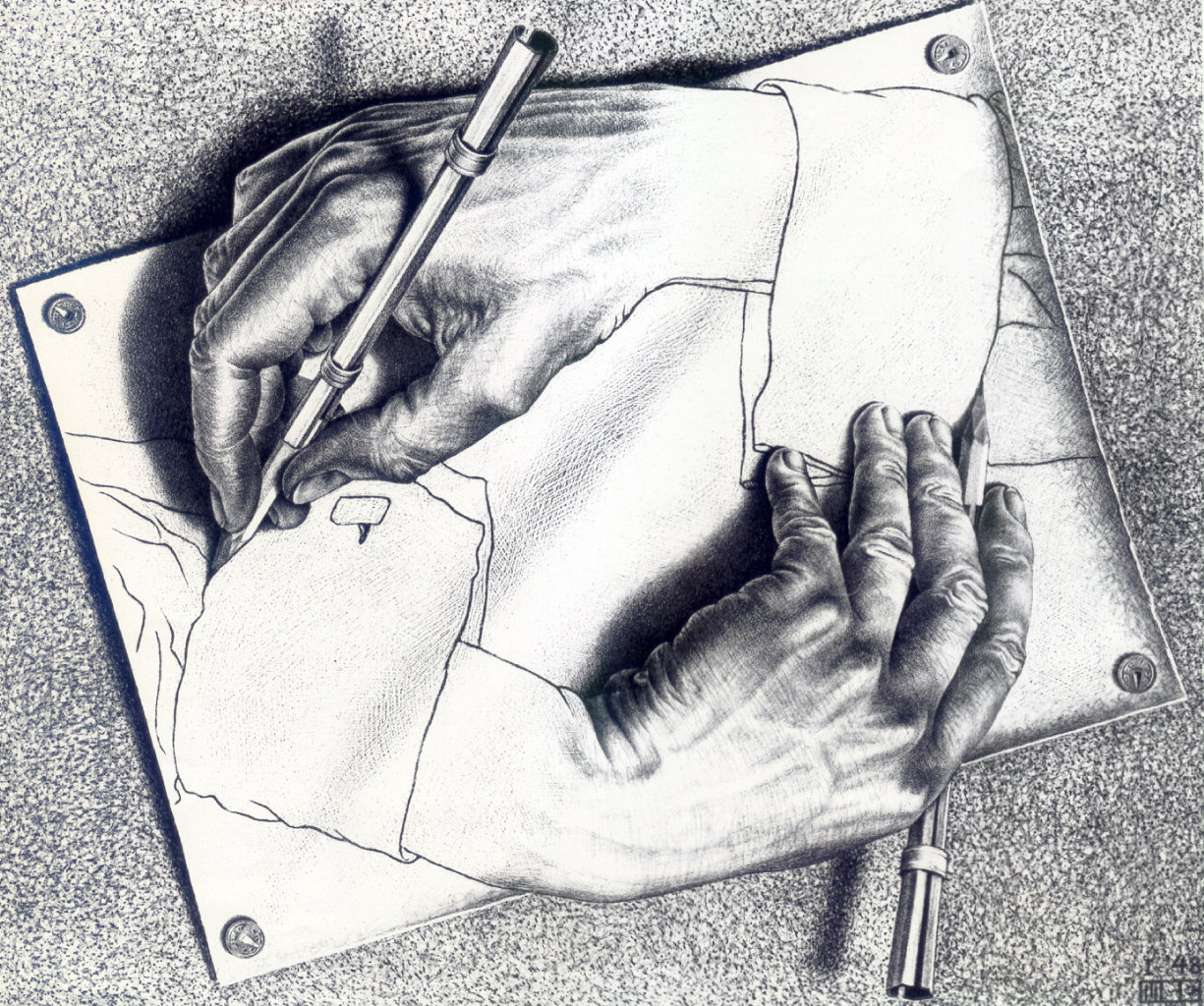"We adore chaos because we love to
produce order." -M.C. Escher
 |
| M.C. Escher |
What is the context
and how did that influence the work?
Maurits Cornelis
Escher, better known as M.C. Escher, was born in 1898 and died in 1972. M.C.
Escher is best known for his graphic art. Throughout his life, he created 448
lithographs and wood carvings. Most people interested in Escher’s work notice
the “impossible construction” that his art portrayed. While in Arnhem, Escher
failed his high school exams and was enrolled in the School for Architecture
and Decorative Arts. There he studied architecture for a week and decided to
switch to graphic art after a teacher advised him to. Once finished with his
schooling Escher traveled through Italy for 11 years. In Italy, he sketched
various scenes and ideas. With the total 2000 sketches M.C. Escher is known to
have drawn, he later added these sketches into completed prints and
lithographs. Examples of this are the background of Waterfall, which
is his Italian period, and the trees in Puddle are the same
trees in Pineta of Calvi, a woodcut. During his trip to Spain in
1922, Escher became fascinated in Regular Division of the Plane. This
technique, demonstrated in the construction of Alhambra, became a hobby for
Escher that he strictly pursued. He combined Regular Division of the Plane with
other techniques for his drawings.
 |
| Waterfall |
 |
| Puddle |
 |
| Pineta of Calvi |
What is the artist
communicating and how?
M.C. Escher’s work can
be described as communicating observation and fantasy. One of Escher’s quotes,
stating, “are you really sure that a floor can’t also be a ceiling?” shows
these themes in action. His work has been seen by critics and the public as being
too intelligent and lyrical. While to some this was off-putting, it intrigued
others. Escher’s work is shown to be naturally mathematical. He tinkered with
perspective and impossible space. Many of the objects he drew were of nature
that could not be physically recreated. Though many of his drawing could not be
reconstructed they could easily be described using mathematics. Escher simply
uses black, white, and the grays in-between to create dimensions that make the
impossible seem possible. In single pieces M.C. Escher combines two and
three-dimensional drawings to create mathematically challenging ideas. An
example of this type of artwork is Reptiles. In this piece the
lizards come out of a drawing, walk around, and make their way back into the
two-dimensional pencil drawing. Much of Escher’s creativity comes from his mind
and imagination rather than direct objects. Like Drawing Hands,flatness
coexists with space to create artistic illusion. His distinctive techniques
continue to impact art and mathematics.
 |
| Reptiles |
 |
| Drawing Hands |
Why do I find it
beautiful?
The artwork of M.C.
Escher is beautiful to me because of its simplicity. The idea that the use of
smooth black, white, two-dimensional, and three-dimensional designs can create
such challenging pieces is aesthetically pleasing. Concrete lines and the ease
of shading make the pieces bounce into life. I also really enjoy how
people dislikes Escher’s work because they thought it was too intellectual.
This shows the fantasy that his pieces brought to the mind. What one person sees
when they look at the artwork may be different from what someone else focuses
in on. It gives the viewers a sense of imagination to add story and life into
Escher’s work. Mathematics is a true language that is reasonably always true.
This “language” used to describe Escher’s work makes impossible construction of
empty space a sound description. Observation of personal fantasies is Escher’s
way to understand the world around him more calmly. M.C. Escher frequently used
items and places that he saw in his travels as backgrounds and starting points
in his graphic art. He also took the ideas of patterns in palaces and
other architecture such as tessellation. This is beautiful because Escher makes
unique connections between everyday patterns and his own fantasies.
 |
| M.C. Escher at work |
 |
| Tessellation technique |








For awhile I was always curious to know who the artist of these sketches were, and after reading your analysis I'm glad you chose him! I agree that his work is very calculated, and it's evident that much planning and time were invested to achieve such compelling masterpieces. Each time I see the above drawings they evoke a sense of hypnotism and can be almost be categorized as surrealism. All the elements are placed in out of the ordinary positions
ReplyDeleteand the contours for the subject matters vary from one sketch to the next. I also agree with you that the monochromatic contrast is aesthetically pleasing because of the minimalism it conveys and the idea that less is more. Adding each one hint of color would distract from the overall beauty and complexity of each piece.
This comment has been removed by the author.
ReplyDeleteI’ve seen his work before but never knew the context behind it and who he was. Your analysis was very well written and planned out. It was easy to follow and very interesting! I like how you included quotes because that helps give more of a background as to who the artist is. I found your beauty analysis very intriguing especially the “language” part used to describe Escher’s work and I agree that the simplicity is beautiful.
ReplyDelete